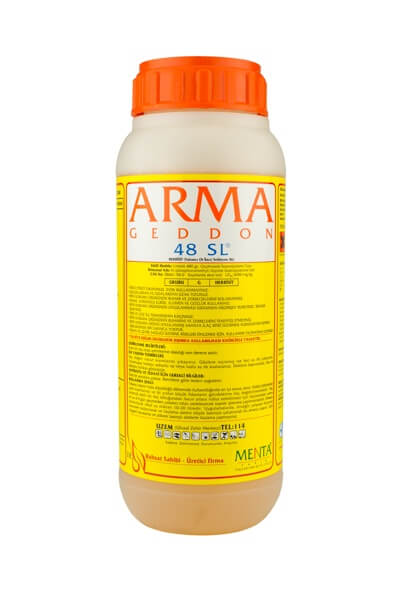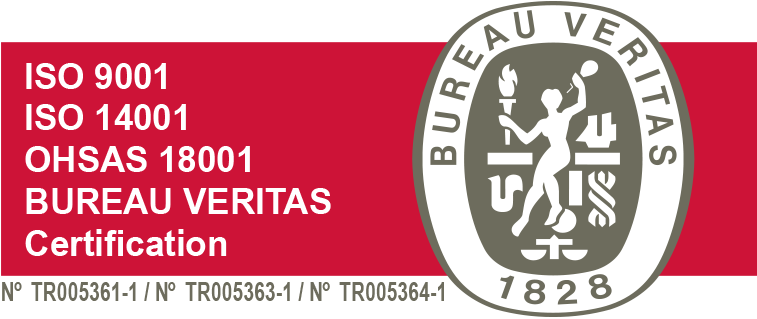Product Certificate and Label
| Name of Product | : | ARMAGEDDON 48 SL |
| Active Substance | : | 480 gr / L Glyphosate Isopropylamin Salt |
| Formulation Type | : | Solution (S) |
| Feature | : | It is a systemic herbicide, effective for all weeds and not selective, that is used after weeds grow. |
| Group | : | G HERBICIDE |
| Toxicity | : | In rats acute oral LD 50:5600 mg/kg |
| Environmental Effect | : | Toxic to bees, birds and fishes. |
| Antidote | : | There is no specific antidote. Treatment is administered according to the symptoms. |
PREPERATION OF THE PESTICIDE FOR APPLICATION
The device’s tank is filled with water in half. The pesticide that is prepared as a pre-mixture is added to the tank. The tank is filled with water while the mixer is working. Spraying is started at a suitable time without waiting too long.
MISCIPLITY
It is suggested to be used without mixing with other herbal medicines.
USAGE AND TIME
The best result is achieved if it used when weeds grow fast. The herbicide should not be touched to the green parts of the cultivated plants and the trunks of small saplings that are younger than 2 years. Since the medicine is a systemic herbicide, in order to enable the medicine to diffuse into the weeds, a soil cultivation that would harm weeds should not be carried out unless at least 4-5 days pass after spraying. The ideal amount of water per decare is 10-20 liters. During sprayings, for example if tee jet is used and spraying device is run on low pressure, the purpose is reached. Spraying should not be performed when it is too windy and with high-pressure devices.
RESISTANCE MANAGEMENT
The plant protection product named ARMAGEDDON is a herbicide, classified as Group G in terms of its active substance. Repeated application of same group plant protection products that has the same effect mechanism encourages resistance development. For this reason, in order to delay resistance development, do not exceed total suggested number of usage of ARMAGEDDON within the same season. In case repetition of the application is needed, make sure you use those plant protection products with different effect mechanism (other than Group G).
| PLANTS AND WEEDS FOR WHICH IT IS USED | ||
| NAME OF PLANT | NAME OF WEED | DOSAGE AND TERM |
| Citrus fruits, Vineyard, Hazelnut,Fruit Gardens and non-cultivated fields | Annual Weeds | 300 ml/da |
| Wild oat grass (Avena sterilis) | Period when weeds are young and actively grow. | |
| Parsnip (Dacus carota) | ||
| Barren brome (Bromus sterilis) | ||
| Canary grass (Phalaris spp.) | ||
| Grass vetch (Lathyrus nissolia) | ||
| Deadnettle (Lamium spp.) | ||
| Groundsel (Senecio vernalis) | ||
| Meadow foxtail (Alopecurus myosuroides) | ||
| Dog mercury (Mercurialis annua) | ||
| Cilician mustard (Octhodium aegyptiacum) | ||
| Butter flower (Ranunculus arvensis) | ||
| Herb robert (Geranium dissectum) | ||
| Bird vetch (Vicia spp.) | ||
| Chickweed (Stellaria media) | ||
| Wild mustard (Sinapis arvensis) | ||
| Mallow (Malva parviflora) | ||
| Alfalfa (Medicago spp.) | ||
| Purslain (Porlutaca oleracea) | ||
| Mole plant (Euphorbia spp.) | ||
| Goosefoot (Chenopdium album) | ||
| Heliotrope (Chorzophora tinctoria) | ||
| Common cocklebur (Xanthium strumarium) | ||
| Spiny cocklebur (Xanthium spinosum) | ||
| Red-rooted pigweed (Amaranthus retroflexus) | ||
| Sweet woodruff (Setaria viridis) | ||
| Barnyard grass (Echinocloa crus-galli) | ||
| Dotted barnyard grass (Echinocloa colonum) | ||
| Cockscomb (Amaranthus albus) | ||
| Green cockscomb (Amaranthus viridis) | ||
| Perennial Weeds | 600 ml/da | |
| Railway, road sides, airports,factory gardens, historical sites,water and drainage channels,field sides etc. | Buckthorn (Cyperus rotundus) | Pre-flowering period when weeds actively grow |
| Dog’s tooth grass (Cynodon dactylon) | ||
| Field bindweed (Convolvulus arvensis) | ||
| Stinging nettle (Urtica dioica) | ||
| Absinth (Artemisia vulgaris) | ||
| Johnson grass (Sorghum halepense) | ||
| Against bush-like and wood-like plants | 1000 ml/da during active growing period | |




